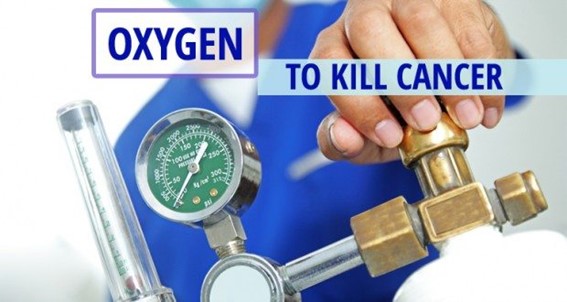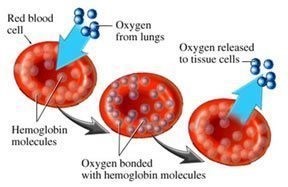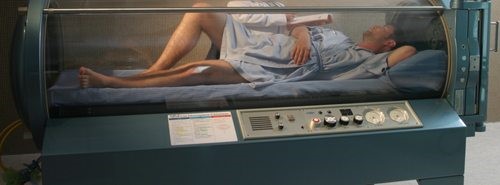This image on Nathan Crane’s site reminds us of oxygen’s healing power and necessity. In the above case, the child was put under high oxygen pressure in a Hyperbaric chamber. Dr. Arthur C. Guyton says, “All chronic pain, suffering, and diseases are caused by a lack of oxygen at the cell level.” Insufficient oxygen means insufficient biological energy, resulting in anything from mild fatigue to life-threatening disease.
“Oxygen plays a pivotal role in the proper functioning of the immune system,” said Dr. Parris M. Kidd. Low oxygen conditions lead directly to inflammation. Chronic inflammation mirrors our body’s low oxygen state.
In all severe disease states, we find a concomitant low oxygen state.
Low oxygen in the body tissues is a sure indicator of disease.
Hypoxia, or lack of oxygen in the tissues, is the
fundamental cause for all degenerative diseases.
Dr. Stephen Levine – Molecular Biologist
A fundamental truth lies at the core of cardiovascular vitality: the heart cannot thrive without oxygen. The silent rhythm of cellular respiration drives every beat, contraction, and arterial pulse — and oxygen is its most essential fuel, which depends on healthy CO2 levels. Oxygen offers remarkable benefits for cancer patients if you can gobble down enough. Why? Because of hypoxia (low oxygen conditions) in the body forces cells to turn cancerous.
Modern humans are oxygen-deprived due to:
-
Sedentary lifestyles
-
Indoor, polluted, or recycled air
-
Mouth breathing, overbreathing
-
Chronic inflammation or anemia
-
Emotional and physical stress
-
Magnesium deficiencies
-
Vascular Disease
Oxygen’s role in heart and vascular health is often underestimated. We speak of cholesterol, blood pressure, and plaque, but we rarely address the one molecule most capable of restoring the heart and all organs from the inside out. Too many doctors forget the basics of life and don’t understand how oxygen can be used in cancer treatment and the treatment of all diseases. It is, after all, the most basic nutrition needed on a moment-to-moment basis. It’s the giver of life.
-
Oxygen powers ATP synthesis, which fuels myocardial contractions and everything else in the body.
-
It prevents anaerobic metabolic stress, which leads to lactic acid buildup and ischemia.
-
It enhances nitric oxide (NO) production, improving vasodilation and arterial elasticity.
-
It supports mitochondrial resilience in cardiac and endothelial cells
When oxygen availability drops due to poor respiration, anemia, microvascular blockages, or mitochondrial dysfunction, the entire cardiovascular system fails at the cellular level. When oxygen availability drops, cells start fermentation, which easily results in cancer.
The British Lung Foundation says, “Breathing in air with a higher concentration of oxygen can be used to correct a low oxygen level in the blood. If you feel breathless and tired, particularly when moving around, you may have low blood oxygen levels.”

Treating cancer with the triad of voltage, alkalinity, and oxygen is an interesting new approach because it treats the fundamental reasons cancer cells form and get aggressive. Most interesting is that voltage, alkalinity, and oxygen levels track each other. They all increase or decrease together, yet we can use treatment approaches focusing on each of the triad’s arms.
Increasing oxygen is the most critical factor in creating proper pH because no wastes or toxins can leave the body without first combining with oxygen. The more alkaline you are, the more oxygen your fluids can hold and keep. Oxygen also buffers/oxidizes metabolic waste acids, helping to keep you more alkaline. The quickest way to increase oxygen and pH is through the administration of sodium bicarbonate, and that is why bicarbonate has always been a mainstay in emergency room and intensive care medicine. Of course, when we increase oxygen and pH levels, we simultaneously increase cellular voltage. In physics, pH is a measurement of voltage.
“The Secret of Life is both to feed and nourish the cells and let them flush their waste and toxins,” according to Dr. Alexis Carrell, Nobel Prize recipient in 1912. Dr. Otto Warburg, also a Nobel Prize recipient, in 1931 & 1944, said, “If our internal environment was changed from an acidic oxygen deprived environment to an alkaline environment full of oxygen, viruses, bacteria, and fungus cannot live.”
Magnesium is vital to oxygen sufficiency.
Magnesium deficiency leads to problems in oxygen
transport and efficient use of oxygen in the mitochondria.
Medical Conditions Linked to Oxygen Deficiency
-
Ischemic heart disease (angina, heart attacks)
-
Stroke and TIA (transient ischemic attacks)
-
Vascular dementia and cognitive decline
-
Hypertension and microvascular constriction
-
Peripheral artery disease
-
Cancer
Magnesium and the Shape of Red Blood Cells

Red blood cell (RBC) deformability is a crucial factor in determining the movement of red blood cells through microcirculation. The mechanism whereby red cells maintain their biconcave shape has been the subject of numerous studies. One of the critical factors for maintaining biconcave shape is the red cell adenosine triphosphate (ATP) levels. The interaction of calcium, magnesium, and ATP with membrane structural proteins plays a significant role in controlling the shape of human red blood cells.
Abnormal magnesium-deprived red blood cells
lack the flexibility to enter tiny capillaries.
In healthy people, most red blood cells are smooth-surfaced and concave-shaped with a donut-like appearance. These discocytes have extra membranes in the recessed area that would enable them to move through capillary beds, delivering oxygen, nutrients, and chemical messengers to tissue and removing carbon dioxide and lactic acid.
Magnesium enhances the binding of oxygen to haem proteins. The concentration of Mg2+ in red cells is relatively high, but free Mg2+ is much lower in oxygenated red blood cells than in deoxygenated ones. This suggests some kind of magnesium pump where oxygen climbs aboard the red cells, and magnesium jumps off, only to jump right back on the red cells again.
Inflammation is the most common cause of tissue hypoxia and/or decreased circulation. Both inflamed tissues and the areas surrounding malignant tumors are characterized by hypoxia. Inflammation can lead to sepsis, circulatory collapse, and ultimately multi-system organ failure.
Endothelial cells may become damaged
when the environment is inflammatory.
In all these conditions, oxygen deficiency — not just mechanical blockage — is a key driver of pathology. Capillary flow disturbances limit oxygen diffusion exchange in lungs and tissue and may, therefore, cause hypoxemia and tissue hypoxia.
Why Oxygen Is So Essential in Cardiovascular Health via NO (Nitric Oxide)
-
Vasodilation: NO relaxes vascular smooth muscle — a function directly dependent on oxygen availability through eNOS.
- pEndothelial function: Without oxygen, endothelial NO production fails, contributing to hypertension, atherosclerosis, and heart failure.
-
Exercise performance: In oxygen-rich states, eNOS-produced NO helps optimize blood flow and oxygen delivery to tissues.
Emerging clinical practice shows that controlled oxygen interventions can support heart and vascular repair:

-
Hyperbaric oxygen therapy (HBOT) has shown promise in post-stroke recovery, wound healing, and even reversing early signs of vascular dementia. Hyperbaric oxygen acts as a drug, eliciting varying response levels at different dosages, and has proven effective as adjunctive therapy for many conditions. This treatment is beneficial for patients who cannot do EWOT training.
-
EWOT (Exercise with Oxygen Therapy) combines movement with oxygen saturation to promote endothelial repair, mitochondrial biogenesis, and cardiac function. High levels of CO2 allow high levels of oxygen intake.
-
Hydrogen and Oxygen Inhalation Therapy – “H2 inhibited cancer cell viability, migration, and invasion, and catalyzed cell apoptosis and H2 induced A549 and H1975 cells G2/M arrest. Besides, H2 down-regulated the expression of NIBPL, SMC3, SMC5, and SMC6 and reduced the expression of Cyclin D1, CDK4 and CDK6.
-
Chlorine Dioxide – Chlorine dioxide contributes to oxygenation by releasing molecular oxygen (O₂) into the bloodstream, especially in small, diluted oral doses. It improves red blood cell flexibility and oxygen-carrying capacity and reduces pathogen-induced hypoxia in cases of infection. This makes ClO₂ a critical agent in oxygen-deficient disease states, from chronic illnesses to cardiovascular dysfunction.
-
Hydrogen | Peroxide (H2O2) – Hydrogen is the oldest oxygen therapy form known. It provides the body with extra oxygen. Supporters consider H2O2 one of the greatest healing miracles of all time, and it belongs right next to sodium bicarbonate, potassium bicarbonate, iodine, selenium, sulfur, and magnesium as basic medicines in every medicinal cabinet.
-
Carbon Dioxide Inhalation Therapy – CO2 is the most powerful way to release armies of oxygen into the cells. It is CO2 that liberates oxygen for healing. It also plays a key role in Nitric Oxide, a crucial gas involved in various physiological processes, including vasodilation, neurotransmission, and immune responses. Bicarbonates yield CO2, which results in high levels of O2.
-
Ozone and singlet oxygen therapies have modulated inflammation and improved blood rheology.
Oxygen therapy is as excellent as it is because more oxygen translates into more cellular healing and energy to help us feel relaxed and perform better in life. Significantly enough, when ample oxygen rushes into oxygen-deficient cells, oxygen is no longer the limiting reagent for detoxifying cellular poisons that have been accumulating.
Oxygen is invincible in its ability to give or take away life, and that goes as much for cancer cells as it does for healthy human cells. Oxygen can heal and kill, so it is perfect for infections of all types. Every ozone user knows this. One cannot stay physically present on earth forever, but with enough oxygen, eternal youth can be ours until our time is up!
Dr.Sircus is a reader-supported publication. To receive new posts and support my work, consider becoming a free or paid subscriber.
Subscribe now





comments